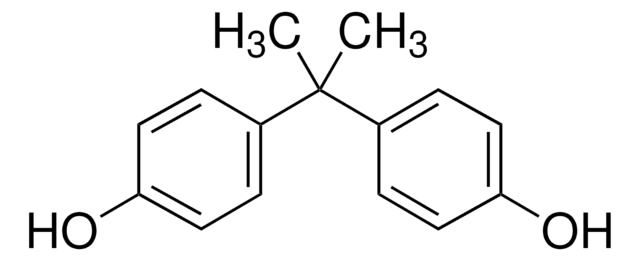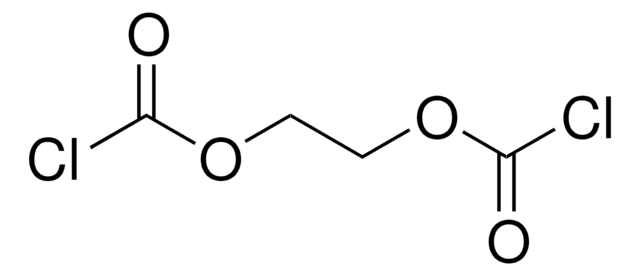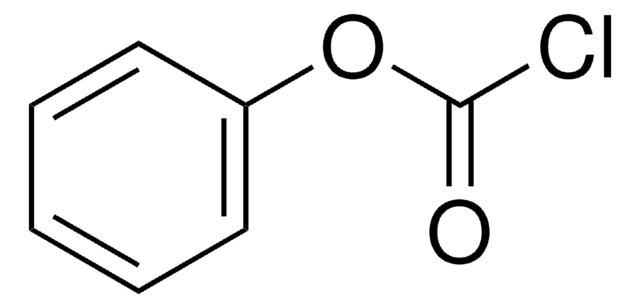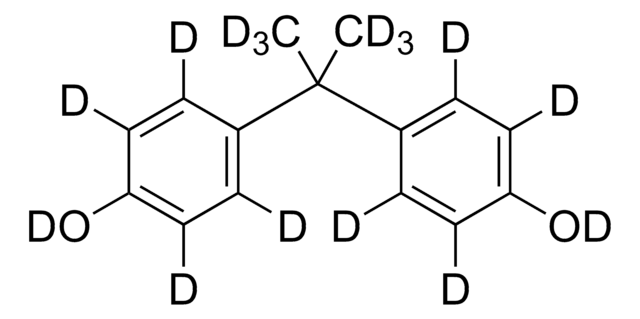About This Item
Fórmula linear:
(ClCO2C6H4)2C(CH3)2
Número CAS:
Peso molecular:
353.20
Número CE:
Número MDL:
Código UNSPSC:
12352100
ID de substância PubChem:
NACRES:
NA.22
Produtos recomendados
Nível de qualidade
Ensaio
95%
pf
90-92 °C (lit.)
temperatura de armazenamento
2-8°C
cadeia de caracteres SMILES
CC(C)(c1ccc(OC(Cl)=O)cc1)c2ccc(OC(Cl)=O)cc2
InChI
1S/C17H14Cl2O4/c1-17(2,11-3-7-13(8-4-11)22-15(18)20)12-5-9-14(10-6-12)23-16(19)21/h3-10H,1-2H3
chave InChI
MMWCQWOKHLEYSP-UHFFFAOYSA-N
Categorias relacionadas
Descrição geral
Bisphenol A (BPA) is reported as an environmental endocrine disrupting chemical that affects reproduction in wildlife. BPA is a monomer of polycarbonate plastics and forms an important constituent of epoxy and polystyrene resins, used in the food packing industry. Effect of bisphenol A bis(chloroformate) on conversion of 3T3-L1 fibroblasts to adipocytes is reported.
Aplicação
Bisphenol A bis(chloroformate) is suitable for use in the synthesis of poly(carbonates) derived from diphenols that contain Si or Ge. It may be used:
- in the preparation of novel electro-optic (EO) polycarbonates containing two different kinds of nonlinear optical (NLO) chromophores with tricyanofurane (TCF) electron acceptor
- in the preparation of novel fluorine-containing poly(carbonate-block-siloxanes)
- as coupling reagent in the synthesis of block-copolymers containing poly(2,6-dimethyl-1,4-phenylene oxide) (PPO) and polycarbonate of bisphenol A (PC) segments
Palavra indicadora
Danger
Frases de perigo
Declarações de precaução
Classificações de perigo
Acute Tox. 3 Oral - Eye Dam. 1 - Skin Corr. 1B
Código de classe de armazenamento
6.1A - Combustible acute toxic Cat. 1 and 2 / very toxic hazardous materials
Classe de risco de água (WGK)
WGK 3
Ponto de fulgor (°F)
Not applicable
Ponto de fulgor (°C)
Not applicable
Equipamento de proteção individual
Eyeshields, Faceshields, Gloves, type P2 (EN 143) respirator cartridges
Escolha uma das versões mais recentes:
Já possui este produto?
Encontre a documentação dos produtos que você adquiriu recentemente na biblioteca de documentos.
Os clientes também visualizaram
Fluorine-containing poly (carbonate-block-siloxane) copolymers.
Anashkin DO, et al.
Polymer Science, Series A, 51(13), 2841-2849 (2013)
PPO-PC block-copolymers used as compatibilizers in PS/PC blends.
Sartore L, et al.
Journal of Applied Polymer Science, 100(6), 4654-4660 (2006)
Hiroshi Masuno et al.
Journal of lipid research, 43(5), 676-684 (2002-04-25)
The confluent cultures of 3T3-L1 fibroblasts were treated with or without bisphenol A (BPA) for 2 days and subsequently treated with insulin (INS) alone for 9 days. When BPA was absent during the first 2-day treatment period, the cultures contained
Facile synthesis and electro-optic activities of new polycarbonates containing tricyanofuran-based nonlinear optical chromophores.
Deng G, et al.
Journal of Polymer Science Part A: Polymer Chemistry, 51(13), 2841-2849 (2013)
Synthesis and characterization of poly (carbonates) derived from diphenols that contain silicon or germanium.
Tagle LH, et al.
Journal of Inorganic and Organometallic Polymers and Materials, 13(1), 21-28 (2003)
Nossa equipe de cientistas tem experiência em todas as áreas de pesquisa, incluindo Life Sciences, ciência de materiais, síntese química, cromatografia, química analítica e muitas outras.
Entre em contato com a assistência técnica












